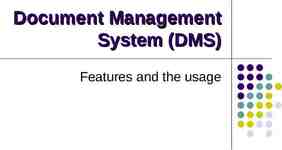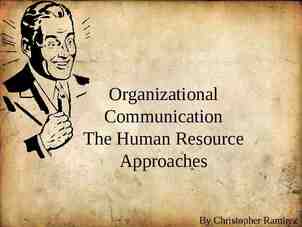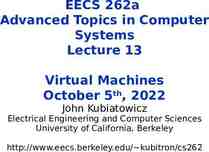HOW TO READ AN RFP and ASSESSING READINESS TO WRITE A PROPOSAL CUNY
24 Slides3.22 MB
HOW TO READ AN RFP and ASSESSING READINESS TO WRITE A PROPOSAL CUNY Central Office of Research: NSF Strategic Positioning webinars Sept 10, 2021 Adam Greenberg Grants Director ASRC [email protected] du Effie MacLachlan, PhD CUNY Office of Research 646.664.8908 Linda Vigdor, MFA, PhD Associate Director of Proposal Development ASRC, Graduate Center, CUNY [email protected]
HANDOUTS / WORKSHEETS Analyzing an RFP worksheet 4 sample NSF RFPs Recommended proposal development timeline (FYI) ASRC Fall 2021 Grants 101 Bootcamp flyer & registration information ASRC / LV 01/25/2024 2
https://deevybee.blogspot.com/2013/03/ten-things-than-can-sink-grant-proposal.html 01/25/202 4 3
The RFP IS YOUR PRIMARY PROPOSAL GUIDE Key Questions: WHAT IS AN RFP? WHAT IS IT FOR? HOW SHOULD YOU READ IT? WHEN SHOULD YOU REFER TO IT? ASRC / LV 01/25/2024 4
SOME PROGRAMS DON’T ISSUE FULL RFPS ASRC / LV – not for distri 01/25/202 4 5
EXAMPLE PROPOSALS A. Solicited proposal: Ecology and Evolution of Infectious Diseases program https://beta.nsf.gov/funding/opportunities/ecology-and-evolution-infectious-diseases-eeid Program page – note: Synopsis, updates, Due dates / guidelines, Contacts, what’s been funded, & the solicitation (RFP) B. Unsolicited proposals: Atmospheric Chemistry https://www.nsf.gov/funding/pgm summ.jsp?pims id 11692&org ERE&sel org ERE&from fund Other good examples: Program that supports students, underrepresented groups S-STEM - NSF Scholarships in Science, Technology, Engineering, and Mathematics Program https://www.nsf.gov/funding/pgm summ.jsp?pims id 5257 Center program, with international component Centers of Research Excellence in Science and Technology (CREST) and HBCU Research Infrastructure for Science and Engineering (HBCU-RISE) https://www.nsf.gov/funding/pgm summ.jsp?pims id 6668 01/25/2024 6
WHY SPEND TIME READING / REREADING THE PROGRAM ANNOUNCEMENT? Investigate program fit Assess eligibility Assess resources (yours and what funding would provide) Identify proposal submission requirements Assess readiness to apply / potential competitiveness ASRC 01/25/202 4 7
Using the RFP Make sure you have the current RFP Q: How do you find this out? Before writing READ & UNDERSTAND the RFP Assess eligibility (institutional and PI) Review the program parameters Think about the Deadline – will you have time to write a competitive proposal RFP instructions always supersede NSF’s Proposal & Award Policies & Procedures Guide (PAPPG) Q: Where can you find the PAPPG? For what is not stated in the RFP, follow the PAPPG! Make sure you have the current PAPPG ASRC 01/25/2024 8
BEFORE YOU GET TOO DEEP IN THE RFP: 1. Contact your Sponsored Research Office to involve them at the start! 2. When was the RFP issued? How do you know if it is still current? 3. What are the due dates? 4. What are the eligibility requirements for having a role in the proposed project? 5. Are there limits on institutional eligibility? ASRC / LV 01/25/2024 9
HOW DO YOU KNOW WHO TO CONTACT AT NSF? Where does NSF direct types of questions? Where would you likely direct questions about the budget? ASRC / LV 01/25/2024 10
ESSENTIAL QUESTIONS WHILE DIGESTING THE RFP What is NSF looking to fund via the RFP? Why? How can you determine if your idea is a fit? Just how competitive is the program? What’s the budget, time frame, and related parameters? Does NSF require a pre-proposal process for this solicitation? Are there cross-disciplinary / cross institution / international expectations? What, specifically, do you need to write and submit? What 2 documents are not mentioned in the RFP? How should you handle those (and how do you justify this)? How are proposals reviewed? Who are you writing to? Where can you research what’s been funded? Should you? ASRC 01/25/2024 11
FORMATTING, PAGES ALLOWED, & OTHER PROPOSAL PREPARATION REQUIREMENTS See NSF’s “PROPOSAL & AWARD POLICIES AND PROCEDURES GUIDE” 20-1 version – the PAPPG is normally updated every January. This year, the new version is effective for proposals submitted after October 4, 2021 It will state formatting and other requirements, including required proposal elements Remember that the RFP supersedes the PAPPG https://www.nsf.gov/publications/pub summ.jsp?ods key pappg& WT.z pims id 0 Not following the rules (RFP or PAPPG) could mean your proposal gets returned without review! ASRC / LV 01/25/2024 12
RFP VS. PAPPG PAPPG* Updated yearly – be certain you have the current PAPPG! Rules for preparing and formatting a proposal Rules on contents of certain documents. Rules about required forms to use (biosketch, C&P, collaborators) Rules about budget items Rules for submitting a proposal Rules for post award RFP requirements supersede the PAPPG ASRC * Proposal & Award Policies & Procedures Guide 01/25/202 4 13
It all starts with the RFP! WHAT EXACTLY DOES THE RFP SAY? HOW SHOULD POINTS BE INTERPRETED? ASRC 01/25/2024 14
ASRC 01/25/2024 15
FOR QUESTIONS ABOUT A SPECIFIC NSF PROGRAM / RFP Who should you ask? ASRC 01/25/202 4 16
HANDOUT (TO USE AS NEEDED): WORKSHEET FOR ANALYZING THE RFP Analyze the RFP for expectations for the program AND your fit Research the sponsor and program Research what has been funded!!! Note the funding level – will it realistically align with your goals Identify the criteria for reviewing proposals – we will go into this in depth later What documents do you need to write or collect? What are the required, expected, and suggested elements needed for the proposal? Know the formatting requirements Make a plan for action (writing as well as working with your collaborators) Identify the program officer(s) and find their contact info ASRC 01/25/2024 17
ARE YOU READY TO WRITE A PROPOSAL? CONSIDERATIONS ASRC 01/25/2024 18
MINIMUM ASPECTS OF READINESS A fundable idea Fits within NSF’s mission Fits the RFP Basic rather than applied research (nearly always) The research is likely to fill a critical knowledge or societal need and to advance the relevant STEM field A compelling research problem and questions Sufficient preliminary work or data An excellent understanding of the RFP / program requirements & expectations Sufficient time to develop a competitive proposal A qualified PI and team (if multi-PI or collaborative) ASRC 01/25/202 4 19
WHAT DOES IT TAKE TO COMPETE -TIME & A MINDSET Realistic timelines for: Developing & refining the idea, significance, innovation, etc. Writing & Revising: To germinate significant research questions To develop the proposal’s logical connections and flow To design Broader Impacts, evaluation To ensure scientific clarity To ensure readability Leave time for internal / external review from colleagues Allot time to be a successful competitor – 3 months ASRC 01/25/2024 20
RESEARCHING WHAT’S BEEN FUNDED NSF program websites: ”Awards made through this program” – a searchable database! Why research what has been funded? ASRC 01/25/202 4 21
RECOMMENDED PLANNING TIMELINES FOR DEVELOPING A COMPETITIVE PROPOSAL See your Sponsored Programs Office for timelines and requirements for submitting specific proposal components and to identify what type of support is offered Center & highly collaborative proposals: 1 year out, minimum Regular and single PI proposals: 3-6 months out,minimu m ASRC 01/25/202 4 22
ASRC GRANTS 101 BOOTCAMP INFO & REGISTRATION The focus will be conceptualizing your research to fit a specific federal funding agency or major non-profit sponsor (e.g., NSF, NIH, NEH, DOD, DOE, IES, Spencer, Simons, etc.) Activities will include some lectures, homework assignments, and group discussions with constructive feedback on ideas and work-in-progress. Groups of no more than 8 faculty will meet for 2.5 hours a week. Target participants: Research active CUNY faculty who have not yet previously written & submitted a grant proposal to a federal funding agency PIs with NIH funding who would like to learn how to reframe their research to fit NSF CUNY tenure track assistant professors who plan to apply for the ASRC’s NSF CAREER Bootcamp in 2022 and have not been the PI on a prior positively reviewed NSF proposal (not necessarily funded) and/or need to start conceptualizing their research and objectives COMPLETING THE 101 BOOTCAMP MAY BE A PREREQUISITE FOR ACCEPTANCE INTO THE 2022-23 ASRC NSF CAREER BOOTCAMP THERE MAY ALSO BE A FULL PROPOSAL WRITING BOOTCAMP this winter, following the 101 Bootcamp, with participation by application or invitation. Deadline for registering: Wednesday, September 22nd, 5 PM Info (once updated): https://asrc.gc.cuny.edu/research-opportunities/faculty-opportunities/bootcamps/ Registration link: https://asrc.formstack.com/forms/asrc grants101 2021 ASRC 01/25/202 4 23
THANK YOU! More Q&A ASRC 01/25/202 4 24





























